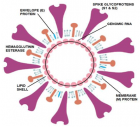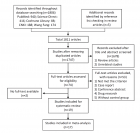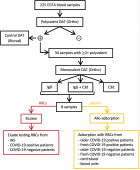Table of Contents
An Adult Case of Beta Thalassemia with Right Ventricular Outflow Tract Tachycardia: A Case Report
Published on: 17th December, 2024
Beta thalassemia major is a genetic disorder requiring recurrent blood transfusion leading to iron overload in endocrine glands and major organs like the heart. Iron overload in the heart may lead to many conduction abnormalities. This is a case repo... rt of a 20-year-old female who was on recurrent blood transfusion. She was on chelation therapy for iron overload. She developed Right Ventricular Outflow Tract Tachycardia (RVOT) which could not be managed with chemical or electrical cardioversion. Her condition was successfully managed with an Automatic Implantable Cardioverter Defibrillator (AICD) implantation and no ventricular tachycardia was observed even after four years of follow-up. Show more >
In Coronary Angiography, Transradial Versus Transfemoral Access: What Are Patients’ Perspectives?
Published on: 16th December, 2024
Objective: Current guidelines favour radial access (TRA) over femoral access (TFA) for percutaneous coronary interventions due to lower bleeding risks and quicker patient recovery. This study compares patient satisfaction and complications betwe... en the two methods to identify the most suitable access route in coronary angiography (CAG).Materials and methods: A total of 152 patients who underwent CAG between February and June 2024 at our clinic were included. The operator and patient made access site decisions. Patients were surveyed 24 hours post-procedure, and complications were tracked for one month. The primary endpoint was patient satisfaction, while complications were classified as minor and major bleeding, pseudoaneurysm, hematoma, and spasm.Results: Of the 152 patients, 33% (n = 50) underwent TRA and 67% (n = 102) underwent TFA. Minor bleeding occurred in 16% (n = 24) and major bleeding in 0.02% (n = 3) patients. Pre-procedure anxiety, satisfaction with the access method, and awareness of TRA showed no significant differences between groups. However, post-procedure pain was higher in the TRA group (46% vs. 15%, p < 0.001), and systolic blood pressure was slightly elevated in the TRA group. Anxiety was more common in females, while elderly and obese patients showed no significant differences in bleeding or complications.Conclusion: Despite TRA’s benefits, no significant difference in satisfaction between TRA and TFA was observed. Patient preferences, radial artery spasms in females, and improved TFA techniques may influence outcomes. A shared decision-making process between operator and patient seems optimal for access site choice, with further investigation into patient satisfaction factors warranted. Show more >
eHealth Literacy and Gender Disparities: Insights from an Internal Survey
Published on: 26th November, 2024
The increasing reliance on digital health services, particularly in light of recent global health crises, has highlighted the importance of eHealth literacy. This study explores the role of eHealth literacy in managing health outcomes, with a specifi... c focus on gender disparities. Using data from the “Truck Tour-Banca del Cuore 2023” survey, which included 354 participants, we examined how integrated technology influences health monitoring and management strategies. Our findings underscore the critical role of eHealth literacy in improving health outcomes and reducing gender disparities, particularly in the context of digital health interventions. Show more >
Prevention of Atrial Fibrillation using Vaughan Williams Class IC Drugs for Multiple Premature AtrialContractions: A Clinical Observational Study
Published on: 8th November, 2024
Background: Atrial fibrillation (A-Fib) poses a significant clinical challenge, particularly in the elderly and those with hypertension. If A-Fib represents one stage in the spectrum of electrical degeneration caused by aging-induced remodeling of th... e left atrial wall, catheter ablation is not an essential treatment. The efficacy of Vaughan Williams Class IC drug in preventing the progression of multiple premature atrial contractions (mPAC) toward paroxysmal atrial fibrillation (PAF) and A-Fib in the earlier stage of histological change was investigated.Method and results: Group A (4 patients with mPAC) and Group B (9 patients with PAF) were treated with Class IC drugs. Treatment outcomes were compared between these two Groups and Group C (8 patients with chronic A-Fib). Follow-up assessments were performed to evaluate the maintenance of sinus rhythm. All mPAC patients maintained sinus rhythm during the follow-up period. In the PAF group, 8 out of 9 patients maintained their sinus rhythm. Conclusion: Early treatment with Class IC drugs shows promise in preventing the progression of A-Fib and maintaining sinus rhythm in patients with mPAC and PAF. These findings highlight the potential role of pharmacological therapy in delaying the onset of A-Fib, thereby improving clinical outcomes and reducing the need for invasive procedures such as ablation. Show more >
Causes of Coronary Angioplasty Denial in Patients Diagnosed with Significant Coronary Artery Disease in East Afghanistan
Published on: 30th October, 2024
Coronary Artery Disease (CAD) is a leading cause of mortality worldwide, with coronary angioplasty being a crucial intervention for patients with significant disease. This study aimed to identify and analyze the causes of coronary angioplasty denial ... in patients with significant coronary artery disease in Afghanistan, focusing on demographic, socioeconomic, and clinical factors.A case-control study was conducted with a sample size of 213 patients diagnosed with significant CAD at tertiary care center in Afghanistan. The case group consisted of 106 patients who were denied angioplasty, and the control group included 107 patients who underwent the procedure. Data were collected on demographic characteristics, comorbidities, education, residence, functional status, income, and the reasons for angioplasty denial. Descriptive statistics and comparative analyses were performed to assess the factors associated with denial.The primary reasons for angioplasty denial were financial constraints (45.3%, p < 0.001), limited hospital facilities (15.1%, p = 0.045), patient refusal (23.6%, p < 0.001), and physician preference for conservative management (12.3%, p = 0.091). Denial rates were higher among patients who were older, had multiple comorbidities, were from rural areas, and had lower education and income levels. Illiteracy and cultural beliefs contributed significantly to patient refusal, while inadequate healthcare infrastructure disproportionately affected rural populations.Financial and infrastructural barriers are the leading causes of coronary angioplasty denial in Afghanistan, exacerbating disparities in healthcare access, particularly among low-income and rural patients. Addressing these issues through policy reforms, improved healthcare infrastructure, and targeted public health education is essential to reducing CAD-related morbidity and mortality in the country. Show more >
Association Between Electrocardiographic Abnormalities and In-Hospital Adverse Outcome in COVID-19 Patients
Published on: 10th October, 2024
Background: SARS-CoV-2 is increasingly recognized for its cardiovascular complications. To address the knowledge gap in our region, this study investigated the relationship between electrocardiographic (ECG) features and in-hospital mortality among C... OVID-19 patients.Methods: A prospective cohort study was conducted involving 140 RT-PCR-confirmed COVID-19 patients at Dhaka Medical College Hospital from August 2021 to July 2022. Patients were divided into two groups based on ECG findings: normal (Group A) and abnormal (Group B). Clinical data and ECG parameters were analyzed using SPSS 24.0.Results: Patients with abnormal ECGs were older, more likely male, and presented with higher rates of dyspnea and palpitations. They were also at increased risk of severe COVID-19 and had longer hospital stays. In-hospital mortality was significantly higher in Group B (21.4% vs.4.3%). ST-T changes and atrial fibrillation were associated with increased mortality. Independent predictors of in-hospital mortality included ECG abnormalities and admission SpO₂ < 90%.Conclusion: ECG abnormalities are significantly associated with adverse outcomes in COVID-19 patients. Further large-scale studies are warranted to strengthen these findings. Show more >
Poor Diet Leading to the Increasing Risk of Atherosclerosis in the World
Published on: 3rd September, 2024
Atherosclerosis Ischemic Cardiovascular Disease (ASICD), one of the leading causes of global deaths, is mainly caused due to the development of plaque on the inner walls of arteries of the human heart. Ischemia refers to the lack of enough oxygen (O2... ), nutrient delivery, and improper waste removal in the cardiac cells. About 90% of cardiovascular diseases in the present world are due to the formation of lipid/cholesterol-based plaques that can form under the lining of the smooth epithelial blood cells. In the US, a study published in the Journal of the American College of Cardiology estimated that poor diet is responsible for about 45% of Cardiovascular Disease. Atherosclerosis doesn’t cause much effect until and unless the plaque becomes unstable due to the accumulation of thrombus that shows Acute Coronary Syndrome. Acute Coronary Syndrome is the result of blockage of blood vessels leading to Myocardial Infarction (Unstable Angina Pectoris). Cardiac Cells require a sufficient amount of Oxygen to function properly. Thus, the demand and supply of oxygen to the cardiac cells should be properly balanced. Atherosclerosis Ischemic Cardiovascular syndrome can worsen if the person is more involved in exercise or emotional stress because at that time their body requires higher oxygen but blood flow gets disrupted due to the formation of plague. Later in the paper, we will discuss the New York Heart Association classification, followed by the top 3 poor diets that are considered to be increasing the cases of cardiovascular disease around the world. Show more >

HSPI: We're glad you're here. Please click "create a new Query" if you are a new visitor to our website and need further information from us.
If you are already a member of our network and need to keep track of any developments regarding a question you have already submitted, click "take me to my Query."



















































































































































